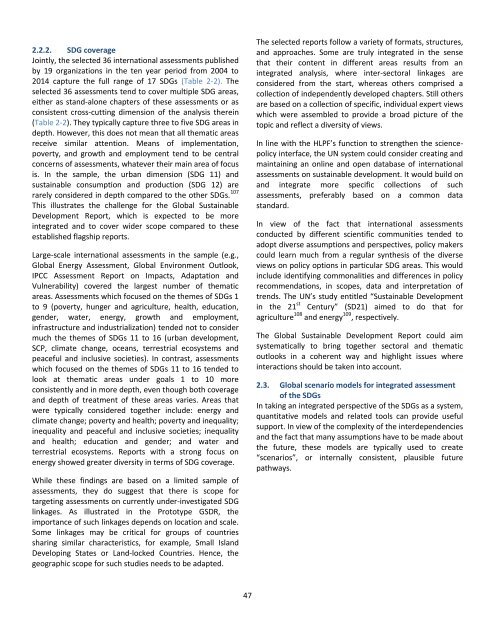1HlG51J
1HlG51J
1HlG51J
You also want an ePaper? Increase the reach of your titles
YUMPU automatically turns print PDFs into web optimized ePapers that Google loves.
2.2.2. SDG coverageJointly, the selected 36 international assessments publishedby 19 organizations in the ten year period from 2004 to2014 capture the full range of 17 SDGs (Table 2-2). Theselected 36 assessments tend to cover multiple SDG areas,either as stand-alone chapters of these assessments or asconsistent cross-cutting dimension of the analysis therein(Table 2-2). They typically capture three to five SDG areas indepth. However, this does not mean that all thematic areasreceive similar attention. Means of implementation,poverty, and growth and employment tend to be centralconcerns of assessments, whatever their main area of focusis. In the sample, the urban dimension (SDG 11) andsustainable consumption and production (SDG 12) arerarely considered in depth compared to the other SDGs. 107This illustrates the challenge for the Global SustainableDevelopment Report, which is expected to be moreintegrated and to cover wider scope compared to theseestablished flagship reports.Large-scale international assessments in the sample (e.g.,Global Energy Assessment, Global Environment Outlook,IPCC Assessment Report on Impacts, Adaptation andVulnerability) covered the largest number of thematicareas. Assessments which focused on the themes of SDGs 1to 9 (poverty, hunger and agriculture, health, education,gender, water, energy, growth and employment,infrastructure and industrialization) tended not to considermuch the themes of SDGs 11 to 16 (urban development,SCP, climate change, oceans, terrestrial ecosystems andpeaceful and inclusive societies). In contrast, assessmentswhich focused on the themes of SDGs 11 to 16 tended tolook at thematic areas under goals 1 to 10 moreconsistently and in more depth, even though both coverageand depth of treatment of these areas varies. Areas thatwere typically considered together include: energy andclimate change; poverty and health; poverty and inequality;inequality and peaceful and inclusive societies; inequalityand health; education and gender; and water andterrestrial ecosystems. Reports with a strong focus onenergy showed greater diversity in terms of SDG coverage.While these findings are based on a limited sample ofassessments, they do suggest that there is scope fortargeting assessments on currently under-investigated SDGlinkages. As illustrated in the Prototype GSDR, theimportance of such linkages depends on location and scale.Some linkages may be critical for groups of countriessharing similar characteristics, for example, Small IslandDeveloping States or Land-locked Countries. Hence, thegeographic scope for such studies needs to be adapted.The selected reports follow a variety of formats, structures,and approaches. Some are truly integrated in the sensethat their content in different areas results from anintegrated analysis, where inter-sectoral linkages areconsidered from the start, whereas others comprised acollection of independently developed chapters. Still othersare based on a collection of specific, individual expert viewswhich were assembled to provide a broad picture of thetopic and reflect a diversity of views.In line with the HLPF’s function to strengthen the sciencepolicyinterface, the UN system could consider creating andmaintaining an online and open database of internationalassessments on sustainable development. It would build onand integrate more specific collections of suchassessments, preferably based on a common datastandard.In view of the fact that international assessmentsconducted by different scientific communities tended toadopt diverse assumptions and perspectives, policy makerscould learn much from a regular synthesis of the diverseviews on policy options in particular SDG areas. This wouldinclude identifying commonalities and differences in policyrecommendations, in scopes, data and interpretation oftrends. The UN’s study entitled “Sustainable Developmentin the 21 st Century” (SD21) aimed to do that foragriculture 108 and energy 109 , respectively.The Global Sustainable Development Report could aimsystematically to bring together sectoral and thematicoutlooks in a coherent way and highlight issues whereinteractions should be taken into account.2.3. Global scenario models for integrated assessmentof the SDGsIn taking an integrated perspective of the SDGs as a system,quantitative models and related tools can provide usefulsupport. In view of the complexity of the interdependenciesand the fact that many assumptions have to be made aboutthe future, these models are typically used to create“scenarios”, or internally consistent, plausible futurepathways.47




